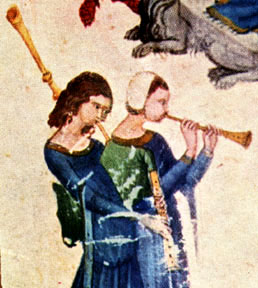The shawm is a loud double-reed instrument which is the ancestor of the oboe. It first appears in the l3th century, and by the end of the Middle Ages was the most important loud instrument in use, finding a place in dance bands as well as ensembles for municipal and court ceremonies. Most medieval towns, for example, had shawm bands on the civic payroll to be on call for social and ceremonial events and to play the “all’s well” from the tower.
Shawm. L’Homme armé (anonymous) performed by the Boston Shawm and Sackbut Ensemble. Ménéstrels hauts et bas (1985), trk 1a.
By the late Middle Ages, the shawm had also developed at least one larger size, called the bombarde, which is distinguishable by its “fontanelle” — a “pepper-shaker” cover of perforated wood for the single key mechanism. Earlier, shawms are sometimes shown combined with buisines (straight trumpets) or bagpipes but, with the addition of the bombard, they are increasingly seen with other shawms and, by the early 15th century, with the slide trumpet in a new standard shawm band.
Shawms and slide trumpet. Gothic Winds. Les Haulz et les Bas. Christophorus CHR 77193 (1996). Trk 17 Qui latuit.
There was also a softer form of shawm which seems to have been popular in the 14th and 15th centuries: the douçaine. The late 15th-century theorist Johannes Tinctoris tells us that, compared to the regular shawm, it had a soft tone and limited range, both of which characteristics were probably the result of a cylindrical rather than conical bore.) It was thus like the later crumhorn, but with the reed held between the lips rather than encased in a windcap. It’s often difficult to tell if we are seeing shawms or douçaines in paintings, but we assume that narrow-bore instruments may sometimes be douçaines rather than the more popular shawms.
Douçaine with voices. Chosi pensoso (excerpt) by Francesco Landini (ca.1325-97), performed by Adam Gilbert with Anna Levenstein and Judith Overcash-Rubin, sopranos (CWRU Collegium Musicum, 1997).





